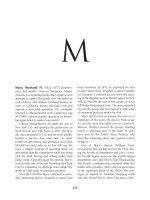Business finance ch 11 cash flow estimation
Bạn đang xem bản rút gọn của tài liệu. Xem và tải ngay bản đầy đủ của tài liệu tại đây (389.38 KB, 37 trang )
CHAPTER 11
Cash Flow Estimation and
Risk Analysis
Relevant cash flows
Incorporating inflation
Types of risk
Risk Analysis
11-1
Proposed Project
Total depreciable cost
Changes in working capital
Equipment: $200,000
Shipping: $10,000
Installation: $30,000
Inventories will rise by $25,000
Accounts payable will rise by $5,000
Effect on operations
New sales: 100,000 units/year @
$2/unit
Variable cost: 60% of sales
11-2
Proposed Project
Life of the project
Economic life: 4 years
Depreciable life: MACRS 3-year class
Salvage value: $25,000
Tax rate: 40%
WACC: 10%
11-3
Determining project value
Estimate relevant cash flows
0
Calculating annual operating cash flows.
Identifying changes in working capital.
Calculating terminal cash flows.
1
2
3
Initial
Costs
OCF1
OCF2
OCF3
NCF0
NCF1
NCF2
NCF3
4
OCF4
+
Terminal
CFs
NCF4
11-4
Initial year net cash flow
Find Δ NOWC.
⇧ in inventories of $25,000
Funded partly by an ⇧ in A/P of $5,000
Δ NOWC = $25,000 - $5,000 = $20,000
Combine Δ NOWC with initial costs.
Equipment
Installation
Δ NOWC
Net CF0
-$200,000
-40,000
-20,000
-$260,000
11-5
Determining annual
depreciation expense
Year
1
2
3
4
1.00
Rate
0.33
0.45
0.15
0.07
$240
x
x
x
x
x
Basis
$240
240
240
240
Depr
$ 79
108
36
17
Due to the MACRS ½-year convention, a
3-year asset is depreciated over 4 years.
11-6
Annual operating cash
flows
1
2
3
4
Revenues 200 200 200
- Op. Costs (60%) -120
- Deprn Expense
-79
Oper. Income (BT)
1
- Tax (40%)
-11
Oper. Income (AT)
1
+ Deprn Expense
79
Operating CF 80 91
200
-120 -120 -120
-108 -36 -17
-28
44 63
18 25
-17
26 38
108
36 17
62 55
11-7
Terminal net cash flow
Recovery of NOWC
$20,000
Salvage value
25,000
Tax on SV (40%) -10,000
Terminal CF $35,000
Q. How is NOWC recovered?
Q. Is there always a tax on SV?
Q. Is the tax on SV ever a positive cash
flow?
11-8
Should financing effects be
included in cash flows?
No, dividends and interest expense
should not be included in the analysis.
Financing effects have already been
taken into account by discounting cash
flows at the WACC of 10%.
Deducting interest expense and
dividends would be “double counting”
financing costs.
11-9
Should a $50,000 improvement
cost from the previous year be
included in the analysis?
No, the building improvement
cost is a sunk cost and should
not be considered.
This analysis should only include
incremental investment.
11-10
If the facility could be leased out
for $25,000 per year, would this
affect the analysis?
Yes, by accepting the project, the firm
foregoes a possible annual cash flow
of $25,000, which is an opportunity
cost to be charged to the project.
The relevant cash flow is the annual
after-tax opportunity cost.
A-T opportunity cost = $25,000 (1 – T)
= $25,000(0.6)
= $15,000
11-11
If the new product line were to
decrease the sales of the firm’s
other lines, would this affect the
analysis?
Yes. The effect on other projects’ CFs is
an “externality.”
Net CF loss per year on other lines
would be a cost to this project.
Externalities can be positive (in the
case of complements) or negative
(substitutes).
11-12
Proposed project’s cash flow time
line
0
1
2
-260
79.7
91.2
3
62.4
Terminal CF →
4
54.7
35.0
89.7
Enter CFs into calculator CFLO
register, and enter I/YR = 10%.
NPV = -$4.03 million
IRR = 9.3%
11-13
What is the project’s
MIRR?
0
-260.0
10%
1
2
3
79.7
91.2
62.4
-260.0
PV outflows
$260 =
$374.8
(1 + MIRR)4
4
89.7
68.6
110.4
106.1
374.8
TV inflows
MIRR = 9.6% < k = 10%, reject the project
11-14
Evaluating the project:
Payback period
0
1
2
3
4
-260
79.7
91.2
62.4
89.7
-89.1
-26.7
63.0
Cumulative:
-260
-180.3
Payback = 3 + 26.7 / 89.7 = 3.3 years.
11-15
If this were a replacement rather
than a new project, would the
analysis change?
Yes, the old equipment would be sold, and
new equipment purchased.
The incremental CFs would be the
changes from the old to the new situation.
The relevant depreciation expense would
be the change with the new equipment.
If the old machine was sold, the firm
would not receive the SV at the end of the
machine’s life. This is the opportunity
cost for the replacement project.
11-16
What if there is expected
annual inflation of 5%, is NPV
biased?
Yes, inflation causes the discount rate
to be upwardly revised.
Therefore, inflation creates a
downward bias on PV.
Inflation should be built into CF
forecasts.
11-17
Annual operating cash flows, if
expected annual inflation = 5%
1
Revenues
210
Op. Costs (60%)
-126
- Deprn Expense
-79
- Oper. Income (BT)
5
- Tax (40%)
2
Oper. Income (AT)
3
+ Deprn Expense
79
Operating CF
82
2
3
4
220 232 243
-132 -139 -146
-108 -36 -17
-20
57
80
-8
23
32
-12
34
48
108
36
17
96
70
65
11-18
Considering inflation:
Project net CFs, NPV, and
IRR
0
1
2
3
4
-260
82.1
96.1
70.0
Terminal CF →
65.1
35.0
100.1
Enter CFs into calculator CFLO register,
and enter I/YR = 10%.
NPV = $15.0 million.
IRR = 12.6%.
11-19
What are the 3 types of
project risk?
Stand-alone risk
Corporate risk
Market risk
11-20
What is stand-alone risk?
The project’s total risk, if it were
operated independently.
Usually measured by standard
deviation (or coefficient of variation).
However, it ignores the firm’s
diversification among projects and
investor’s diversification among firms.
11-21
What is corporate risk?
The project’s risk when considering
the firm’s other projects, i.e.,
diversification within the firm.
Corporate risk is a function of the
project’s NPV and standard
deviation and its correlation with the
returns on other projects in the firm.
11-22
What is market risk?
The project’s risk to a well-diversified
investor.
Theoretically, it is measured by the
project’s beta and it considers both
corporate and stockholder
diversification.
11-23
Which type of risk is most
relevant?
Market risk is the most relevant risk
for capital projects, because
management’s primary goal is
shareholder wealth maximization.
However, since total risk affects
creditors, customers, suppliers, and
employees, it should not be
completely ignored.
11-24
Which risk is the easiest to
measure?
Stand-alone risk is the easiest to
measure. Firms often focus on standalone risk when making capital
budgeting decisions.
Focusing on stand-alone risk is not
theoretically correct, but it does not
necessarily lead to poor decisions.
11-25









